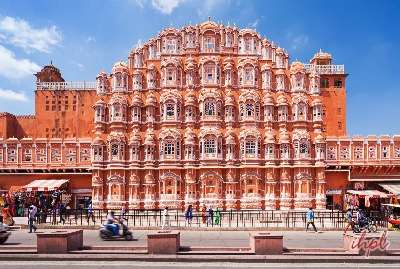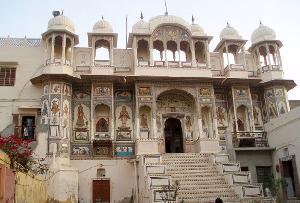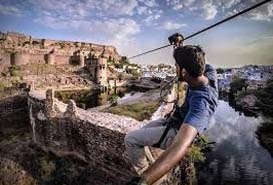Bhagton ki Choti Haveli Nawalgarh, is one of the best known havelis in Nawalgarh. Nawalgarh, a town of Jhunjhunu district in Rajasthan, India, is famous for grand havelis with frescos, which is specialty of the Shekhawati region in Rajasthan. Nawalgarh boasts of some of the best-preserved havelis and finest frescoes in Shekhawati. The Bhagton ki Choti Haveli In Nawalgarh In India, is most definitely one of them.
Nawalgarh was founded in 1737 AD by Thakur Nawal Singh Ji Bahadur (Shekhawat) at the village site of Rohili. Nawalgarh was then encircled on all sides by the high Parkota (walls) comprising of four Pols (gates) in different directions, namely Agoona Darwaja, Bawadi Darwaja (in north), Mandi Darwaja and Nansa Darwaja- each gates have iron doors. The market place of Nawalgarh and the layout of the havelis indicate that the city was well planned before construction. Nawalgarh was considered to be the most modern and well planned towns of Shekhawati region.
The Havelis in Nawalgarh are famous for their frescos and belonged to the affluent traders, of which there were many in Shekhawati. However, many of these havelis have now been transformed into heritage hotels due to the increasing cost of maintenance of these mansions and also because many of the owners have ventured and shifted residences to other states or regions on business.
Bhagton ki Choti Haveli belonged to the Bhagats of Nawalgarh. The Bhgatas were prosperous traders in the region and used the Haveli as their residence. The haveli was established in the later part of the 19th century.
The Bhagton ki Choti Haveli depicts some exquisite frescos and wall and ceiling paintings. The paintings depict a huge panorama of topics ranging from local lores, local legends, scenes from Hindu mythology. Miniature paintings show details of war scenes, hunting scenes and other exotic settings.
Like most havelis in Rajasthan, the Bhagton ki Choti Haveli has a massive carved wooden gate that opens into a courtyard that lead to yet another courtyard. This second courtyard leads to the main building. The rooms, hallways and corridors are all covered with the intricate paintings. The dominant colors are golden, blue, indigo, green, maroon that will set your eyes ablaze.












